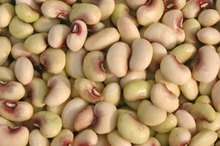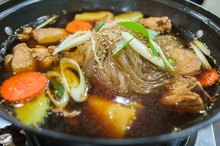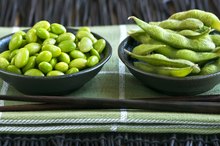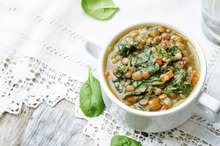Vegetarian Chili Nutrition Information
Chili is a stew-like soup that most often includes meat, chilies and chili powder. However, chili can be made with a number of different ingredients, including beans, tomatoes and even chocolate. Vegetarian chili typically contains beans and sometimes a soy-based meat substitute. The U.S. Department of Agriculture recommends you include more meatless meals in your diet, and a vegetarian chili can help meet that need.
Types
Whether making vegetarian chili at home or eating a ready-made variety, its contents vary greatly. You can make your own vegetarian chili that includes different types of beans, or just soy meat crumbles and various types of vegetables. Types of ready-made vegetarian chilies include all bean, black bean, bean and vegetables or beans and soy meat crumbles.
Serving Size and Calories
Souvlaki Nutrition Information
Learn More
A homemade vegetarian chili that includes a variety of vegetables, spices and kidney beans featured on Allrecipes.com makes eight servings and contains 155 calories per serving. Hormel brand makes a vegetarian chili with beans that contains 190 calories in a 247-gram portion. Amy's Kitchen organic medium chili contains 280 calories in a 1 cup serving, and its black bean vegetarian chili contains 200 calories in a 1 cup serving.
Carbohydrates and Fiber
Vegetables and beans are naturally high in fiber, making vegetarian chili a high fiber food item. Including more fiber in your diet can lower your blood cholesterol levels and improve bowel function. In addition, fiber takes longer to digest, aiding in hunger and weight control. Adult women need 21 to 25 grams of fiber a day, and adult men need 30 to 38 grams of fiber per day. A serving of homemade vegetarian chili contains 29 grams of carbohydrates and 8 grams of fiber. Hormel's vegetarian chili with beans contains 35 grams of carbohydrates and 10 grams of fiber. Amy's Kitchen organic black bean chili contains 31 grams of carbohydrates and 13 grams of fiber, while the medium chili contains 35 grams of carbohydrates and 7 grams of fiber.
- Vegetables and beans are naturally high in fiber, making vegetarian chili a high fiber food item.
- Hormel's vegetarian chili with beans contains 35 grams of carbohydrates and 10 grams of fiber.
Protein
The Nutrition and Fiber in Crowder Peas
Learn More
In addition to being high in fiber, legumes also act as a good source of protein, making it a healthy alternative to meat sources of protein. However, the protein in legumes does not provide all of the essential amino acids, making it an incomplete source of protein. Eating a diet that includes a variety of foods, such as whole grains and vegetables, will ensure you meet all your essential amino acid needs. A serving of homemade vegetarian chili has 8 grams of protein. Hormel's vegetarian bean chili contains 11 grams of protein per serving. Amy's Kitchen black bean chili contains 13 grams of protein per serving, and its medium chili contains 15 grams of protein per serving.
- In addition to being high in fiber, legumes also act as a good source of protein, making it a healthy alternative to meat sources of protein.
- However, the protein in legumes does not provide all of the essential amino acids, making it an incomplete source of protein.
Fat
Without meat, most vegetarian chilies are very low in fat. A serving of homemade vegetarian chili contains 3 grams of total fat. A serving of Hormel's vegetarian chili with beans contains 1 gram of total fat. Amy's Kitchen organic black bean chili contains only 3 grams of total fat per serving, but its medium vegetarian chili contains 9 grams of total fat per serving.
- Without meat, most vegetarian chilies are very low in fat.
- A serving of homemade vegetarian chili contains 3 grams of total fat.
Related Articles
References
- Hormel: Vegetarian Chili with Beans: Nutrition Information
- Amy's Kitchen: Beans and Chili
- What's Cooking America: History of Chili
- Allrecipes.com: Insanely Easy Vegetarian Chili
- MedlinePlus: Fiber
- Hever J. Plant-Based Diets: A Physician's Guide. Perm J. 2016;20(3):15–082. doi:10.7812/TPP/15-082
- Hever J, Cronise RJ. Plant-based nutrition for healthcare professionals: implementing diet as a primary modality in the prevention and treatment of chronic disease. J Geriatr Cardiol. 2017;14(5):355–368. doi:10.11909/j.issn.1671-5411.2017.05.012
- Wald, A., Seres, D., Grover, S., Patient education: High-fiber diet (Beyond the Basics). UptoDate. Sep 14, 2018
- Medline Plus. Facts About Polyunsaturated Fats.
- Clarys P, Deliens T, Huybrechts I, et al. Comparison of nutritional quality of the vegan, vegetarian, semi-vegetarian, pesco-vegetarian and omnivorous diet. Nutrients. 2014;6(3):1318–1332. Published 2014 Mar 24. doi:10.3390/nu6031318
- David L Katz, Kimberly N Doughty, Kate Geagan, David A Jenkins, Christopher D Gardner, Perspective: The Public Health Case for Modernizing the Definition of Protein Quality, Advances in Nutrition, doi:10.1093/advances/nmz023
- Clarys P, Deliens T, Huybrechts I, et al. Comparison of nutritional quality of the vegan, vegetarian, semi-vegetarian, pesco-vegetarian and omnivorous diet. Nutrients. 2014;6(3):1318–1332. Published 2014 Mar 24. doi:10.3390/nu6031318
- David L Katz, Kimberly N Doughty, Kate Geagan, David A Jenkins, Christopher D Gardner, Perspective: The Public Health Case for Modernizing the Definition of Protein Quality, Advances in Nutrition, doi:10.1093/advances/nmz023
- Hever J, Cronise RJ. Plant-based nutrition for healthcare professionals: implementing diet as a primary modality in the prevention and treatment of chronic disease. J Geriatr Cardiol. 2017;14(5):355–368. doi:10.11909/j.issn.1671-5411.2017.05.012
- Hever J. Plant-Based Diets: A Physician's Guide. Perm J. 2016;20(3):15–082. doi:10.7812/TPP/15-082
- Medline Plus. Facts About Polyunsaturated Fats.
- Wald, A., Seres, D., Grover, S., Patient education: High-fiber diet (Beyond the Basics). UptoDate. Sep 14, 2018
Writer Bio
Jill Corleone is a registered dietitian and health coach who has been writing and lecturing on diet and health for more than 15 years. Her work has been featured on the Huffington Post, Diabetes Self-Management and in the book "Noninvasive Mechanical Ventilation," edited by John R. Bach, M.D. Corleone holds a Bachelor of Science in nutrition.









